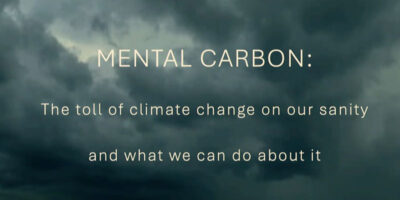
If you’re reading this article, chances are you care about the environment. And if you care about the environment, you’ve probably felt some level of anxiety about our future as a species and a planet. The bad news? Well, it’s warranted. But the good news is that there’s still hope: not just for your mental health, but for the world.
In March 2024, environmental journalist Jeremy Hance came to the UW–Madison campus to speak at a Weston Roundtable Lecture, hosted by the Nelson Institute’s Center for Sustainability and the Global Environment. In his talk,“Mental Carbon: The Toll of Climate Change on Our Sanity and What We Can Do About It,” Hance discussed the real drivers behind climate anxiety, its definition and degrees, and tools for coping.
Here are four things you might not have known about climate anxiety.

- Climate anxiety has a definition.
“A chronic fear of environmental doom,” Hance said. It can manifest as grief, despair, anxiety, and pessimism. - There are four levels of climate anxiety.
British psychotherapist Caroline Hickman breaks down climate anxiety into mild, moderate, signifiant, and severe. Those with moderate climate anxiety feel upset, but believe there are solutions. People with significant climate anxiety see a significant impact on their daily life, including feelings of guilt and grief. For people with severe climate anxiety, “You believe that society is doomed,” said Hance. This level of anxiety leads to intrusive thoughts, difficulty functioning, or even self harm. -

Slides from Hance’s Weston Roundtable Lecture on March 21, 2024. Your climate anxiety is normal.
“On a moderate level, this is a normal human reaction to the information that you are getting,” Hance shared, compared to a pathological diagnosis of anxiety or depression. “It’s connected to reality. “ - You can train yourself to be resilient.
How? “It’s not exactly fun or easy,” said Hance. Step 1: Let the negative feelings in. “You have to allow yourself to feel the crap. You have to allow yourself to face what it is that you’re afraid of.” Step 2: Grieve the environment and climate you remember. “We are in a weird situation. We usually think of grief as a human-to-human thing. Someone dies, we grieve for them. We are in a situation now where we need to learn how to grieve for non-human things.”
Watch the full talk to learn more about the relationship between mental health and climate change — including more tools for managing climate anxiety.
The Weston Roundtable — a public lecture series and a 1-credit class made — is possible by a generous donation from Roy F. Weston, a highly accomplished UW–Madison alumnus. Designed to promote a robust understanding of sustainability science, engineering, and policy, these interactive lectures are cosponsored by the Center for Sustainability and the Global Environment, the Department of Civil and Environmental Engineering, and the Office of Sustainability.
